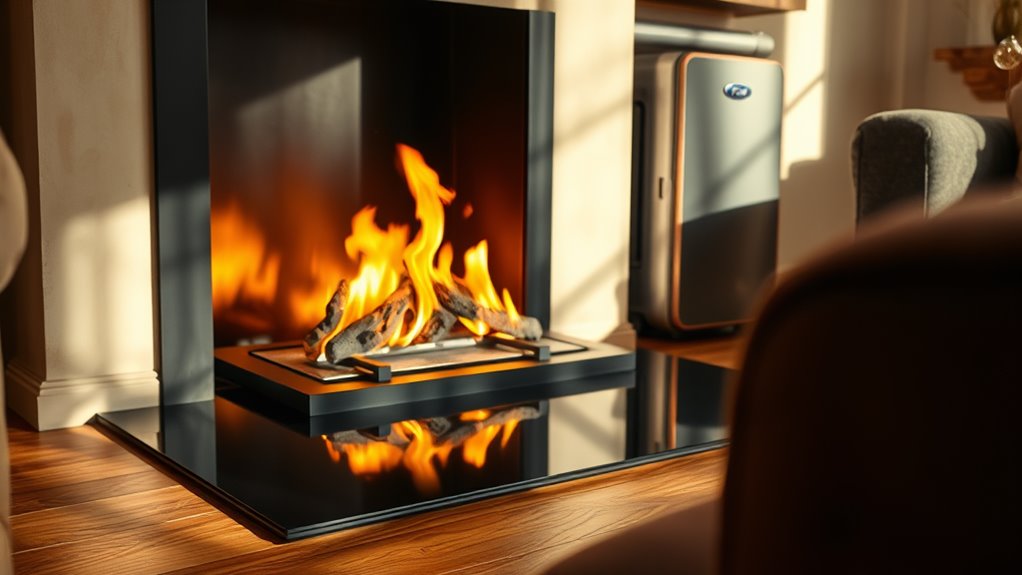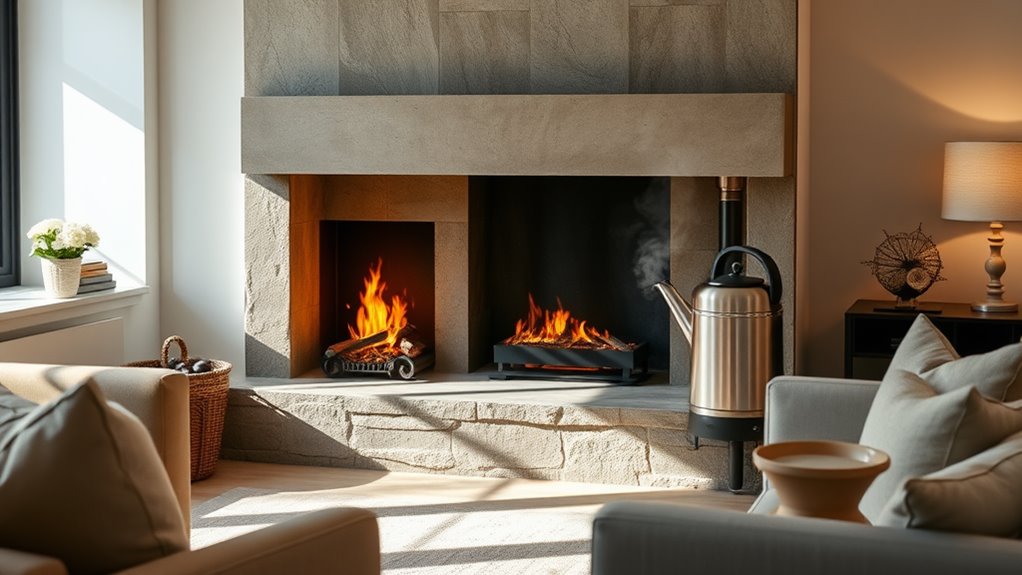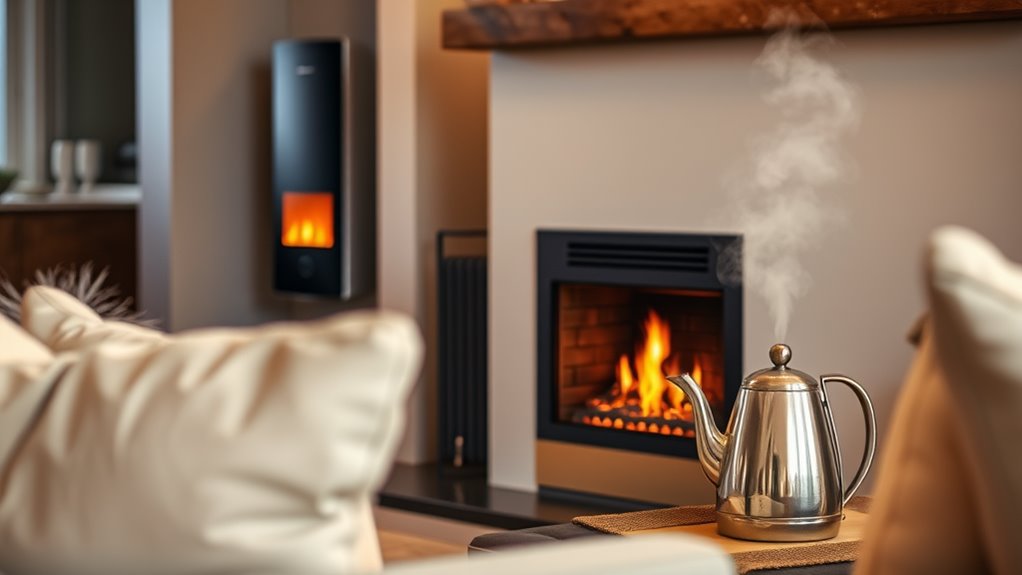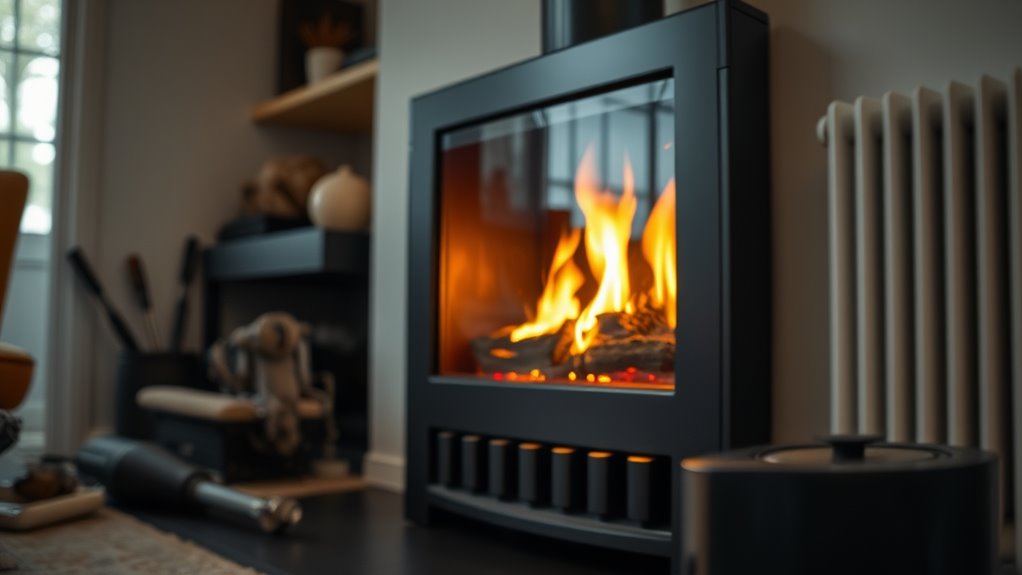Yes, you can still find gas fires with back boilers on the market today. They blend heating efficiency with aesthetic appeal, providing warmth for your home while supplying hot water. However, you need to take into account current regulations, installation requirements, and ongoing maintenance. While they offer several advantages, they also come with some drawbacks. To make an informed decision about your heating options, it's important to explore all aspects of gas fires with back boilers more thoroughly.
Key insights
- Yes, gas fires with back boilers are still available, though their popularity has declined in favor of modern heating solutions.
- Contemporary models offer improved energy efficiency and aesthetic designs that fit modern home décor.
- Installation must comply with current regulations and safety standards, requiring qualified professionals for setup.
- Regular maintenance and inspections are essential to ensure safe and efficient operation of gas fires with back boilers.
- Consider alternatives like electric heating systems or biomass options for potentially better efficiency and lower maintenance needs.
Understanding Back Boilers: What Are They?

When you think about efficient heating solutions for your home, understanding back boilers can be essential. Back boilers have a rich history, originating in the mid-20th century as a compact heating option, designed to integrate with gas fires. These systems utilize heat generated by the fire to warm water, which circulates through radiators or taps, providing both space and water heating. There are primarily two back boiler types: open vented and sealed systems. Open vented systems rely on a cold water tank, while sealed systems operate under pressure, eliminating the need for a tank. By grasping these concepts, you can make informed decisions about integrating back boilers into your home heating strategy effectively. Additionally, understanding the importance of energy efficiency can help you choose a system that lowers operational costs and supports environmental sustainability.
The Evolution of Gas Fires With Back Boilers

As gas fires evolved, their integration with back boilers transformed home heating systems considerably. Initially, historical designs focused on functionality, providing efficient heating but lacking aesthetic appeal. However, modern advancements changed that, leading to:
- Improved Efficiency: Modern gas fires with back boilers now offer higher energy efficiency ratings, reducing energy costs.
- Enhanced Design: Contemporary models come in various styles, blending seamlessly with home décor.
- Smart Technology: Many new units incorporate smart controls, allowing you to manage heating remotely.
- Safety Features: Advanced safety mechanisms guarantee safer operation, minimizing risks associated with older systems.
These developments not only improve heating effectiveness but also elevate the overall experience of using gas fires with back boilers in your home. Additionally, obtaining a Commercial Gas Safety Certificate ensures that these systems are compliant and safe for use.
Current Regulations Surrounding Back Boilers

When considering back boilers, you must comply with current safety standards and energy efficiency guidelines. It's crucial to understand the installation regulations that govern these systems to guarantee maximum performance and safety. This overview will clarify what you need to know to meet legal requirements effectively. Additionally, ensuring compliance with local building regulations is essential to avoid potential fines or operational disruptions.
Safety Standards Compliance
Guaranteeing compliance with current safety standards for back boilers is essential for both functionality and safety. You need to stay updated on regulation updates to guarantee your system operates correctly and safely. Here are some key points to take into account for safety compliance:
- Installation by Qualified Professionals: Always have your back boiler installed by a registered gas engineer.
- Regular Maintenance: Schedule annual inspections to identify any potential hazards or inefficiencies.
- Adequate Ventilation: Guarantee proper airflow around the unit to prevent overheating or gas buildup.
- Emergency Shut-off Mechanism: Verify that your system has a functioning emergency shut-off feature for added safety. Additionally, consider regular servicing to ensure safe and efficient operation, as required by UK gas safety regulations.
Energy Efficiency Guidelines
Understanding energy efficiency guidelines for back boilers is vital for optimizing performance and reducing energy costs. Back boilers should meet specific energy efficiency ratings, often mandated by local regulations. Look for models that have high Annual Fuel Utilization Efficiency (AFUE) ratings, as these indicate better performance and lower operational costs. Regular maintenance also plays an important role in maintaining efficiency; make certain filters and vents are clean. Additionally, take advantage of government incentives designed to promote energy-efficient upgrades. These programs can provide financial assistance for replacing outdated systems with more efficient options. By adhering to these guidelines, you not only improve your home's energy efficiency but also contribute to a more sustainable environment. Furthermore, regular plant room maintenance is essential to ensure that all systems, including back boilers, operate efficiently and safely.
Installation Regulations Overview
While guiding the installation of gas fires with back boilers, you must comply with specific regulations that guarantee safety and efficiency. Understanding these rules can help you navigate potential installation challenges and mitigate regulatory impacts. Here are key regulations to take into account:
- Qualified Professionals: Only registered Gas Safe engineers should perform installations.
- Ventilation Requirements: Adequate ventilation must be provided to prevent carbon monoxide buildup.
- Clearance Specifications: Follow manufacturer guidelines for clearance around the boiler to guarantee safe operation.
- Regular Inspections: Schedule annual inspections to maintain compliance and ensure ongoing safety. Additionally, be aware that regular maintenance can prevent issues like ignition failures, ensuring the system operates efficiently.
Advantages of Gas Fires With Back Boilers

Gas fires with back boilers offer several advantages that make them a practical choice for efficient heating. One significant benefit is energy savings; these systems can utilize gas more efficiently than traditional heating methods, reducing your energy bills. Additionally, they provide a dual function, heating your home while also supplying hot water, further enhancing efficiency. The aesthetic appeal of a gas fire cannot be overlooked, as it adds a cozy and inviting ambiance to your living space. With a variety of designs available, you can select a model that complements your home's decor. Overall, gas fires with back boilers represent a smart investment, balancing functionality with style while helping you save on energy costs. Furthermore, energy-efficient heating systems like commercial heat pumps can achieve up to 400% efficiency, making them an appealing alternative for larger spaces.
Disadvantages of Gas Fires With Back Boilers

Though gas fires with back boilers can be efficient, they do come with some notable disadvantages. Here are a few key points to take into account:
- Inefficiency Concerns: These systems often suffer from reduced efficiency compared to modern heating solutions, leading to higher energy bills.
- Installation Challenges: Installing a gas fire with a back boiler requires significant space and may involve complex plumbing, making it a more cumbersome choice.
- Maintenance Requirements: Regular servicing is essential to guarantee safety and efficiency, which can add to ongoing costs. Regular maintenance is crucial to prevent boiler errors and ensure optimal performance.
- Limited Control: You might find it difficult to control the heat output, as these systems are less responsive to temperature adjustments than standalone heating options.
Carefully weigh these disadvantages against your heating needs before making a decision.
Alternatives to Gas Fires With Back Boilers
As you explore heating options, several alternatives to gas fires with back boilers offer improved efficiency and flexibility. Electric heating systems, such as infrared panels or storage heaters, provide instant warmth and can be more energy-efficient, especially with modern smart thermostats. They require less maintenance and eliminate the need for flues or chimneys, simplifying installation.
Biomass alternatives, like wood pellet stoves, harness renewable energy sources. They burn compressed organic materials, reducing your carbon footprint and often providing significant savings on heating bills. These systems can be integrated with existing heating networks, allowing for versatile solutions. By considering these alternatives, you'll find energy-efficient options to meet your heating needs while promoting sustainability. Additionally, regular maintenance, such as commercial power flushing, can enhance the efficiency of your heating system and prolong its lifespan.
Installation Considerations for Gas Fires
When planning the installation of a gas fire, it's vital to take into account several factors that guarantee safety and efficiency. Proper installation techniques are essential, as they can affect the performance and longevity of your system.
Here are four key considerations:
- Fuel Types: Determine whether you'll use natural gas or LPG, as this influences the installation and appliance choice.
- Ventilation: Provide adequate ventilation to prevent harmful gas buildup.
- Location: Choose a suitable location that complies with local building codes and minimizes flue distance.
- Professional Installation: Always hire a qualified technician to guarantee adherence to safety standards and regulations. Additionally, ensure that the installation is compatible with your boiler's specific error codes to facilitate efficient troubleshooting and maintenance.
Taking these factors into account will help ensure a safe and effective gas fire installation.
Maintenance and Safety Tips for Back Boilers
To guarantee your back boiler operates efficiently and safely, regular maintenance is essential. Schedule annual safety inspections with a qualified technician to check for leaks, corrosion, and proper venting. During these inspections, verify that the pressure relief valve and expansion vessel are functioning correctly.
You should also clean the heat exchanger regularly to prevent blockages and maintain efficiency. Monitor the area around the back boiler for any signs of wear or damage, and address issues immediately. Additionally, keep the boiler area clear of flammable materials. Always check the water levels and look for unusual noises during operation, as these can indicate potential problems. Consistent back boiler maintenance not only extends the life of your system but also guarantees a safe environment in your home.
Cost Analysis: Gas Fires vs. Other Heating Options
While reflecting on various heating options for your home, it's crucial to evaluate the costs associated with gas fires compared to alternatives like electric heaters or oil boilers. A cost comparison reveals key differences in both initial investment and ongoing expenses. Here are four critical factors to reflect upon:
- Installation Costs: Gas fires typically incur lower installation costs than oil boilers.
- Fuel Prices: Gas prices can fluctuate, impacting your monthly bills compared to more stable electric rates.
- Heating Efficiency: Gas fires generally provide higher heating efficiency, often translating into lower energy usage.
- Maintenance Costs: Gas systems usually require less maintenance compared to oil boilers, resulting in potential long-term savings.
Ultimately, understanding these elements helps you make informed decisions about your heating options.
Making the Right Choice for Your Home Heating Needs
How do you determine the best heating solution for your home? Start by evaluating your specific home heating needs and preferences. Consider the size of your space, insulation quality, and existing energy sources. For instance, gas fires with back boilers can provide efficient heating, but you must assess the availability and cost of gas in your area. Additionally, compare other energy sources like electricity, oil, or renewable options. Each has its pros and cons regarding efficiency, installation costs, and environmental impact. Ultimately, prioritize options that align with your budget and sustainability goals. Don't forget to consult with a heating professional to guarantee you make an informed choice tailored to your home's unique requirements.
Frequently Asked Questions
How Long Do Back Boilers Typically Last?
Back boilers typically have a lifespan of 10 to 15 years, depending on usage and maintenance. To maximize your back boiler lifespan, make sure you schedule regular servicing and check for signs of wear. Keep the surrounding area clear and avoid overworking the unit during peak heating seasons. Regularly bleeding radiators and checking pressure levels can also help maintain efficiency and prolong its life, so don't skip these essential maintenance tips.
Can I Replace a Back Boiler With a Regular Boiler?
Yes, you can replace a back boiler with a regular boiler. In fact, many homeowners opt for this back boiler replacement to improve heating efficiency. Regular boilers often provide better performance and are more energy-efficient than older back boilers. When considering the switch, make sure to consult a qualified technician to assess your home's specific needs, ensuring the new system meets your heating demands effectively while adhering to safety standards.
Are Back Boilers Suitable for All Home Sizes?
Back boilers aren't suitable for all home sizes due to their specific heating capacities. While they can provide good back boiler efficiency in smaller homes, larger spaces may require more powerful heating solutions. If your home has multiple rooms or high ceilings, you might find that a regular boiler or alternative heating solutions offer better performance and efficiency. Assess your home's size and heating needs before deciding on a back boiler system.
What Fuel Options Are Available for Back Boilers?
When considering fuel options for back boilers, you'll find various gas options along with other fuel types. Typically, back boilers are designed to run on natural gas or LPG (liquefied petroleum gas). Some models may also accommodate oil or solid fuels, depending on the design. It's essential to check the manufacturer's specifications to guarantee compatibility with your home's heating system and to maximize efficiency and safety.
Do Back Boilers Require a Specific Type of Chimney?
Yes, back boilers typically require specific chimney types to guarantee proper ventilation and safety. You'll need to take into account installation requirements, which often dictate that the chimney must be lined and suitable for the type of fuel used. A conventional chimney or a balanced flue system may be necessary, depending on your boiler's design. It's vital to follow local regulations and consult a professional for ideal installation and compliance.
Summary
In conclusion, while gas fires with back boilers are less common today due to evolving regulations and technology, they can still be a viable heating option for some homes. You should consider the advantages and disadvantages carefully, as well as installation and maintenance requirements. By evaluating your specific heating needs and consulting with professionals, you can make an informed decision that guarantees comfort and efficiency for your home.

